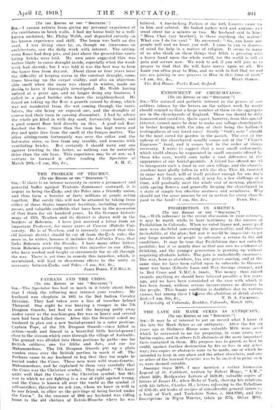[To rue Exam or sae " Sescrssors.")
Sta,—I cannot refrain from giving my personal experience of the ventilators in brick walls. I had my house built by a well- known architect, Mr. Philip Webb, and depended entirely on his known experience and skill. The house was built on dry sand. I was living close by, so, though an ignoramus on architecture, saw the daily work with interest. The sitting- room floors had deep pits, and just above the ground-line venti- lating bricks were laid. My own sense suggested this was rather likely to cause draught inside, especially when the wood- work had shrunk; but I was told it was the best way to keep the house free from dry-rot. About three or four years later the difficulty of keeping warm in the constant draught, some- times blowing up the carpet visibly, and also an objection- Oslo smell when the room was closed in winter, made me deciffix to have it thoroughly investigated. Mr. Webb having retired at a great age,-and no longer doing any business, I called in a good builder who knew the neighbourhood. He found on Inking up the floor a growth caused by damp, which was not wonderful from the wet coming through the venti- lators, the site being en exposed one, and the draughts of course had their turn in causing discomfort. I had by advice the whole pit filled in wills dry sand, fortunately handy, and a good cement floor laid directly on this. A good oak floor finished the floor. Since then the room has kept warm and dry and quite frro from the smell of the fungus matter. The other sitting-room fortunately was over tho cellar and the hot-water stove, so free from any trouble, and remains with ventilating bricks. But certainly I should warn any one against trusting to the latter, as nothing can be naturally drier than the site here. This experience may be of use, so I venture to forward- it after reading the Spectator of



































 Previous page
Previous page